Modeling the Hydropower–Food Nexus in Large River Basins: A Mekong Case Study
Abstract
:1. Introduction
2. Methodology
2.1. Causal Loop Diagrams
- The causal link from variable A to variable B is positive if a change in A produces a change in B in the same direction.
- The causal link from variable A to variable B is negative if a change in A produces a change in B in the opposite direction.
2.2. Limitations of CLDs
2.3. Application to River Basins
3. Results
3.1. Food Supply Influence Model
3.2. Hydropower Supply Influence Model
3.3. Hydropower–Food Supply Nexus Influence Model for the LMB
4. Discussion
4.1. A Complex System
4.2. Strategic Interventions
4.3. Analytical Value
4.4. Novelty
5. Conclusions
Acknowledgments
Author Contributions
Conflicts of Interest
References
- Molden, D. (Ed.) Water for Food, Water for Life a Comprehensive Assessment of Water Management in Agriculture; Earthscan & International Water Management Institute: London, UK; Colombo, Sri Lanka, 2007.
- International Energy Agency (IEA). World Energy Outlook 2012; IEA: Paris, France, 2012. [Google Scholar]
- Hussey, K.; Pittock, J.; Dovers, S. Justifying, extending and applying “nexus” thinking in the quest for sustainable development. In Climate, Energy and Water; Pittock, J., Hussey, K., Dovers, S., Eds.; Cambridge University Press: Cambridge, UK, 2015; pp. 1–5. [Google Scholar]
- Richter, B.D.; Postel, S.; Revenga, C.; Scudder, T.; Lehner, B.; Churchill, A.; Chow, M. Lost in development’s shadow: The downstream human consequences of dams. Water Altern. 2010, 3, 14–42. [Google Scholar]
- Vorosmarty, C.J.; McIntyre, P.B.; Gessner, M.O.; Dudgeon, D.; Prusevich, A.; Green, P.; Glidden, S.; Bunn, S.E.; Sullivan, C.A.; Liermann, C.R.; et al. Global threats to human water security and river biodiversity. Nature 2010, 467, 555–561. [Google Scholar] [CrossRef] [PubMed]
- World Commission on Dams (WCD). Dams and Development: A New Framework for Decision-Making. The Report of the World Commission on Dams; Earthscan: London, UK, 2000. [Google Scholar]
- International Center for Environmental Management (ICEM). MRC Strategic Environmental Assessment (SEA) of Hydropower on the Mekong Mainstream: Final Report; ICEM: Hanoi, Vietnam, 2010. [Google Scholar]
- Hortle, K.G. Consumption and the Yield of Fish and Other Aquatic Animals from the Lower Mekong Basin; Mekong River Commission: Vientiane, Laos, 2007. [Google Scholar]
- Ziv, G.; Baran, E.; Nam, S.; Rodríguez-Iturbe, I.; Levin, S.A. Trading-off fish biodiversity, food security, and hydropower in the Mekong river basin. Proc. Natl. Acad. Sci. USA 2012, 109, 5609–5614. [Google Scholar] [CrossRef] [PubMed]
- Orr, S.; Pittock, J.; Chapagain, A.; Dumaresq, D. Dams on the Mekong River: Lost fish protein and the implications for land and water resources. Glob. Environ. Chang. 2012, 22, 925–932. [Google Scholar] [CrossRef]
- Pittock, J.; Dumaresq, D.; Orr, S. The Mekong River: Trading off hydropower, fish and food. Reg. Environ. Chang. 2016. submitted. [Google Scholar]
- Meadows, D.H. The unavoidable a priori. In Elements of the System Dynamics Method; Randers, J., Ed.; Productivity Press: Portland, OR, USA, 1980; pp. 23–57. [Google Scholar]
- Randers, J. Elements of System Dynamics Method; Productivity Press: Portland, OR, USA, 1980. [Google Scholar]
- Richardson, G.P.; Pugh, A.I., III. Introduction to System Dynamics Modeling with Dynamo; Productivity Press: Portland, OR, USA, 1981. [Google Scholar]
- Forrester, J.W.; Lux, N.; Stuntz, L. Road Maps: A guide to Learning System Dynamics; System Dynamics Group, Sloan School of Management, MIT: Cambridge, MA, USA, 2002. [Google Scholar]
- Sterman, J.D. Business Dynamics: Systems Thinking and Modeling for a Complex World; Irwin/McGraw-Hill: Boston, MA, USA, 2000. [Google Scholar]
- Probst, G.; Bassi, A. Tackling Complexity. A Systems Approach for Decision Makers; Greenleaf Publishing: London, UK, 2014. [Google Scholar]
- Forrester, J.W. Industrial Dynamics; Productivity Press: Portland, OR, USA, 1961. [Google Scholar]
- Proust, K.; Newell, B. Catchment and Community: Towards a Management-Focused Dynamical Study of the Act Water System; The Australian National University: Canberra, Australia, 2006. [Google Scholar]
- Dyball, R.; Newell, B. Understanding Human Ecology: A Systems Approach to Sustainability; Earthscan/Routledge: London, UK, 2014. [Google Scholar]
- Proust, K.; Dovers, S.; Foran, B.; Newell, B.; Steffen, W.; Troy, P. Climate, Energy and Water: Accounting for the Links; Land and Water Australia: Canberra, Australia, 2007; p. 68. [Google Scholar]
- Johnston, R.; Try, T.; de Silva, S. Agricultural Water Management Planning in Cambodia; International Water Management Institute and Australian Centre for International Agricultural Research: Colombo, Sri Lanka, 2013. [Google Scholar]
- Postel, S.; Richter, B. Rivers for Life: Managing Water for People and Nature; Island Press: Washington, DC, USA, 2003; p. 253. [Google Scholar]
- Amornsakchai, S.; Annez, P.; Vongvisessomjai, S.; Choowaew, S.; Kunurat, P.; Nippanon, J.; Schouten, R.; Sripapatrprasite, P.; Vaddhanaphuti, C.; Vidthayanon, C.; et al. Pak Mun Dam, Mekong River Basin, Thailand. A WCD Case Study Prepared as an Input to the World Commission on Dams; World Commission on Dams: Cape Town, South Africa, 2000. [Google Scholar]
- Basin Development Plan Programme (BDPP). Regional Irrigation Sector Review for Joint Basin Planning Process; Basin Development Plan Programme, Mekong River Commission: Vientiane, Laos, 2009. [Google Scholar]
- International Center for Environmental Management (ICEM). MRC SEA for Hydropower on the Mekong Mainstream. Fisheries Baseline Assessment Working Paper; ICEM: Hanoi, Vietnam, 2010. [Google Scholar]
- Food and Agricultural Organization of the United Nations. FAOstat; FAO: Rome, Italy, 2009. [Google Scholar]
- Pech, S. Water sector analysis. In The Water-Food-Energy Nexus in the Mekong Region; Smajgl, A., Ward, J., Eds.; Springer: New York, NY, USA, 2013; pp. 19–60. [Google Scholar]
- Godfray, H.C.J.; Beddington, J.R.; Crute, I.R.; Haddad, L.; Lawrence, D.; Muir, J.F.; Pretty, J.; Robinson, S.; Thomas, S.M.; Toulmin, C. Food security: The challenge of feeding 9 billion people. Science 2010, 327, 812–818. [Google Scholar] [CrossRef] [PubMed]
- Floch, P.; Molle, F. Irrigated agriculture and rural change in Northeast Thailand: Reflections on present developments. In Governing the Mekong: Engaging in the Politics of Knowledge; Daniel, R., Lebel, L., Manorom, K., Eds.; Strategic Information and Research Development Centre: Petaling Jaya, Malaysia, 2013; pp. 185–198. [Google Scholar]
- Phengphaengsy, F.; Noble, A. Reconsidering irrigation management transfer in Laos. In Governing the Mekong: Engaging in the Politics of Knowledge; Daniel, R., Lebel, L., Manorom, K., Eds.; Strategic Information and Research Development Centre: Petaling Jaya, Malaysia, 2013; pp. 137–162. [Google Scholar]
- Thuon, T. Localizing development and irrigation management in Cambodia. In Governing the Mekong: Engaging in the Politics of Knowledge; Daniel, R., Lebel, L., Manorom, K., Eds.; Strategic Information and Research Development Centre: Petaling Jaya, Malaysia, 2013; pp. 163–184. [Google Scholar]
- Brooks, J. Agricultural Policy Choices in Developing Countries: A Synthesis; OECD: Paris, France, 2010. [Google Scholar]
- Ministry for Agriculture and Forestry. Strategy for Agricultural Development 2011 to 2020; Lao PDR Ministry for Agriculture and Forestry: Vientiane, Laos, 2010.
- Tran, C.T. Overview of Agriculture Policy in Vietnam; Food Fertilizer and Technology Center for the Asian and Pacific Region: Taipei, Taiwan, 2014. [Google Scholar]
- Singhapreecha, C. Economy and Agriculture in Thailand; Food Fertilizer and Technology Center for the Asian and Pacific Region: Taipei, Taiwan, 2014. [Google Scholar]
- Trung, N.H.; Tuan, L.A.; Trieu, T.T. Multi-level governance and adaptation to floods in the Mekong delta. In Governing the Mekong: Engaging in the Politics of Knowledge; Daniel, R., Lebel, L., Manorom, K., Eds.; Strategic Information and Research Development Centre: Petaling Jaya, Malaysia, 2013; pp. 111–126. [Google Scholar]
- De Silva, S.; Johnston, R.; Senaratna Sellamuttu, S. Agriculture, Irrigation and Poverty Reduction in Cambodia: Policy Narratives and Ground Realities Compared; CGIAR Research Program on Aquatic Agricultural Systems: Penang, Malaysia, 2014. [Google Scholar]
- International Energy Agency (IEA). Southeast Asia Energy Outlook. World Energy Outlook Special Report; IEA: Paris, France, 2013. [Google Scholar]
- World Bank. Clear Skies. Cambodia Economic Update; World Bank Group: Washington, DC, USA, 2014. [Google Scholar]
- World Bank. Country Partnership Strategy Progress Report for the Lao People’s Democratic Republic; Report No. 90281-la; World Bank Group: Washington, DC, USA, 2014. [Google Scholar]
- World Bank. Country Partnership Strategy for the Socialist Republic of Vietnam for the Period fy12-fy16; Report No. 65200-vn; World Bank Group: Washington, DC, USA, 2011. [Google Scholar]
- The Mekong River Commission (MRC). Mekong Basin Hydropower Database—Master; The Mekong River Commission Secretariat: Vientiene, Laos, 2009. [Google Scholar]
- Central Intelligence Agency (CIA). Thailand; CIA: Langley, VA, USA, 2015. [Google Scholar]
- Fullbrook, D. Food security in the wider Mekong region. In The Water-Food-Energy Nexus in the Mekong Region; Smajgl, A., Ward, J., Eds.; Springer: New York, NY, USA, 2013; pp. 61–104. [Google Scholar]
- Mushtaq, S.; Maraseni, T.N.; Maroulis, J.; Hafeez, M. Energy and water tradeoffs in enhancing food security: A selective international assessment. Energy Policy 2009, 37, 3635–3644. [Google Scholar] [CrossRef] [Green Version]
- Lazarus, K. Mining in the Mekong region. In The Water-Food-Energy Nexus in the Mekong Region; Smajgl, A., Ward, J., Eds.; Springer: New York, NY, USA, 2013; pp. 191–208. [Google Scholar]
- Walker, P.; Rhubart-Berg, P.; McKenzie, S.; Kelling, K.; Lawrence, R.S. Public health implications of meat production and consumption. Public Health Nutr. 2005, 8, 348–356. [Google Scholar] [CrossRef] [PubMed]
- Bender, A. Meat and Meat Products in Human Nutrition in Developing Countries; FAO: Rome, Italy, 1992. [Google Scholar]
- High Level Panel of Experts on Food Security and Nutrition (HLPE). Note on Critical and Eerging Issues for Food Security and Nutrition. Prepared for the Committee on World Food Security; FAO: Rome, Italy, 2014. [Google Scholar]
- Faidley, L. Energy and agriculture. In Energy in Farm Production; Fluck, R., Ed.; Elsevier: Amsterdam, The Netherlands, 1992; pp. 1–12. [Google Scholar]
- Foran, T. Impacts of natural resource-led development on the Mekong energy system. In The Water-Food-Energy Nexus in the Mekong Region; Smajgl, A., Ward, J., Eds.; Springer: New York, NY, USA, 2013; pp. 105–142. [Google Scholar]
- Conforti, P.; Giampietro, M. Fossil energy use in agriculture: An international comparison. Agric. Ecosyst. Environ. 1997, 65, 231–243. [Google Scholar] [CrossRef]
- The Mekong River Commission (MRC). Technical Review Report on Prior Consultation for the Proposed Don Sahong Hydropower Project; The Mekong River Commission Secretariat: Vientiane, Laos, 2015. [Google Scholar]
- Matthews, N.; Motta, S. Chinese state-owned enterprise investment in Mekong hydropower: Political and economic drivers and their implications across the water, energy, food nexus. Water 2015, 7, 6269–6284. [Google Scholar] [CrossRef]
- Dore, J.; Lazarus, K.; Molle, F.; Foran, T.; Kakonen, M. De-marginalizing the Mekong River Commission. In Contested Waterscapes in the Mekong Region: Hydropower, Livelihoods and Governance; Molle, F., Foran, T., Kakonen, M., Eds.; Earthscan: Abingdon, UK, 2012; pp. 357–382. [Google Scholar]
- Belinskij, A. Water-energy-food nexus within the framework of international water law. Water 2015, 7, 5396–5415. [Google Scholar] [CrossRef]
- The Mekong River Commission (MRC). Mekong Basin Planning. The Story Behind the Basin Development Plan. The BDP Story; MRC: Vientienne, Laos, 2013. [Google Scholar]
- Keskinen, M.; Someth, P.; Salmivaara, A.; Kummu, M. Water-energy-food nexus in a transboundary river basin: The case of Tonle Sap Lake, Mekong River basin. Water 2015, 7, 5416–5436. [Google Scholar] [CrossRef]
- Watcharejyothin, M.; Shrestha, R.M. Regional energy resource development and energy security under CO2 emission constraint in the greater Mekong sub-region countries (GMS). Energy Policy 2009, 37, 4428–4441. [Google Scholar] [CrossRef]
- Foran, T. Action research to improve Thailand’s electricity planning processes. In Governing the Mekong: Engaging in the Politics of Knowledge; Daniel, R., Lebel, L., Manorom, K., Eds.; Strategic Information and Research Development Centre: Petaling Jaya, Malaysia, 2013; pp. 49–70. [Google Scholar]
- Karki, S.K.; Mann, M.D.; Salehfar, H. Energy and environment in the ASEAN: Challenges and opportunities. Energy Policy 2005, 33, 499–509. [Google Scholar] [CrossRef]
- Opperman, J.J.; Hartmann, J.; Harrison, D. Hydropower within the climate, energy and water nexus. In Climate, Energy and Water; Pittock, J., Hussey, K., Dovers, S., Eds.; Cambridge University Press: Cambridge, UK, 2015; pp. 79–107. [Google Scholar]
- The Mekong River Commission (MRC). Basin-Wide Rapid Sustainability Assessment Tool; MRC: Vientiene, Laos, 2010. [Google Scholar]
- Godfray, H.C.J.; Garnett, T. Food security and sustainable intensification. Phil. Trans. R. Soc. B 2014, 369, 20120273. [Google Scholar] [CrossRef] [PubMed]
- UN Food and Agricultural Organisation. Strategic Framework 2010–2019; UN Food and Agricultural Organisation: Rome, Italy, 2009. [Google Scholar]
- Water Land and Ecosystems (WLE). Sustainable Intensification of Agriculture: Oxymoron or Real Deal; CGIAR Research Program on Water, Land and Ecosystems: Colombo, Sri Lanka, 2015. [Google Scholar]
- Tscharntke, T.; Klein, A.M.; Kruess, A.; Steffan-Dewenter, I.; Thies, C. Landscape perspectives on agricultural intensification and biodiversity—Ecosystem service management. Ecol. Lett. 2005, 8, 857–874. [Google Scholar] [CrossRef]
- Perfecto, I.; Vandermeer, J. The agroecological matrix as alternative to the land-sparing/agriculture intensification model. Proc. Natl. Acad. Sci. USA 2010, 107, 5786–5791. [Google Scholar] [CrossRef] [PubMed]
- Dugan, P.J.; Barlow, C.; Agostinho, A.A.; Baran, E.; Cada, G.F.; Chen, D.; Cowx, I.G.; Ferguson, J.W.; Jutagate, T.; Mallen-Cooper, M. Fish migration, dams, and loss of ecosystem services in the Mekong basin. Ambio 2010, 39, 344–348. [Google Scholar] [CrossRef] [PubMed]
- Biodiversity and Fisheries Management Opportunities in the Mekong River Basin. Available online: http://69.90.183.227/doc/nbsap/fisheries/Coates.pdf (accessed on 22 September 2016).
- Cowx, I.; Almeida, O.; Bene, C.; Brummett, R.; Bush, S.; Darwall, W.; Pittock, J.; Van Brakel, M. Value of river fisheries. In Proceedings of the Second International Symposium on the Management of Large Rivers for Fisheries, Volume I; Welcomme, R., Petr, T., Eds.; FAO Regional Office for Asia & the Pacific: Bangkok, Thailand, 2004; pp. 1–20. [Google Scholar]
- World Wide Fund (WWF). Free-Flowing Rivers—Economic Luxury or Ecological Necessity; WWF: Gland, Switzerland, 2006. [Google Scholar]
- Anonymous. Yangtze Conservation and Development Report; Chinese Academy of Sciences: Beijing, China, 2007. [Google Scholar]
- Keskinen, M.; Guillaume, J.; Kattelus, M.; Porkka, M.; Räsänen, T.; Varis, O. The water-energy-food nexus and the transboundary context: Insights from large Asian rivers. Water 2016, 8, 193. [Google Scholar] [CrossRef]
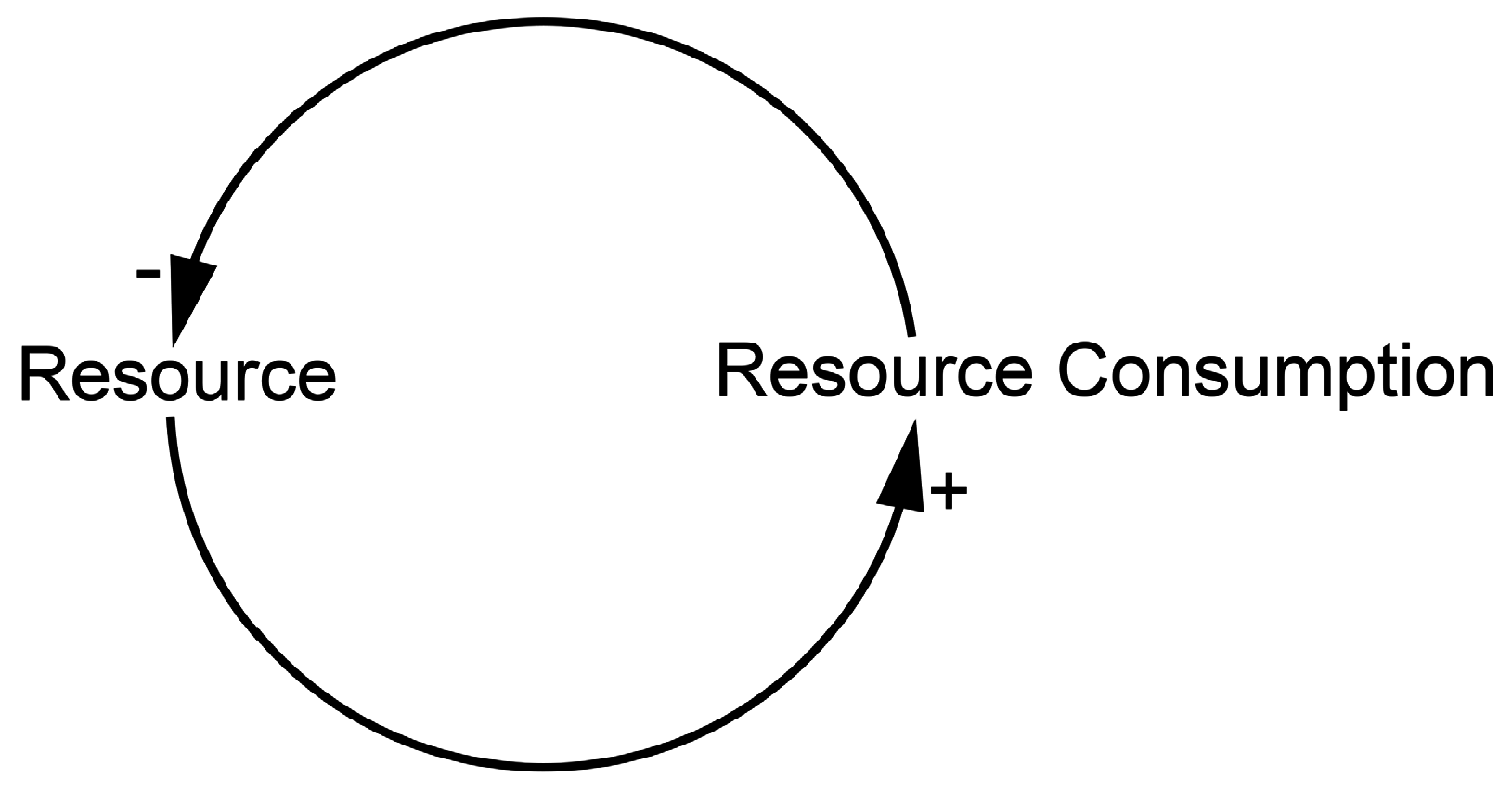
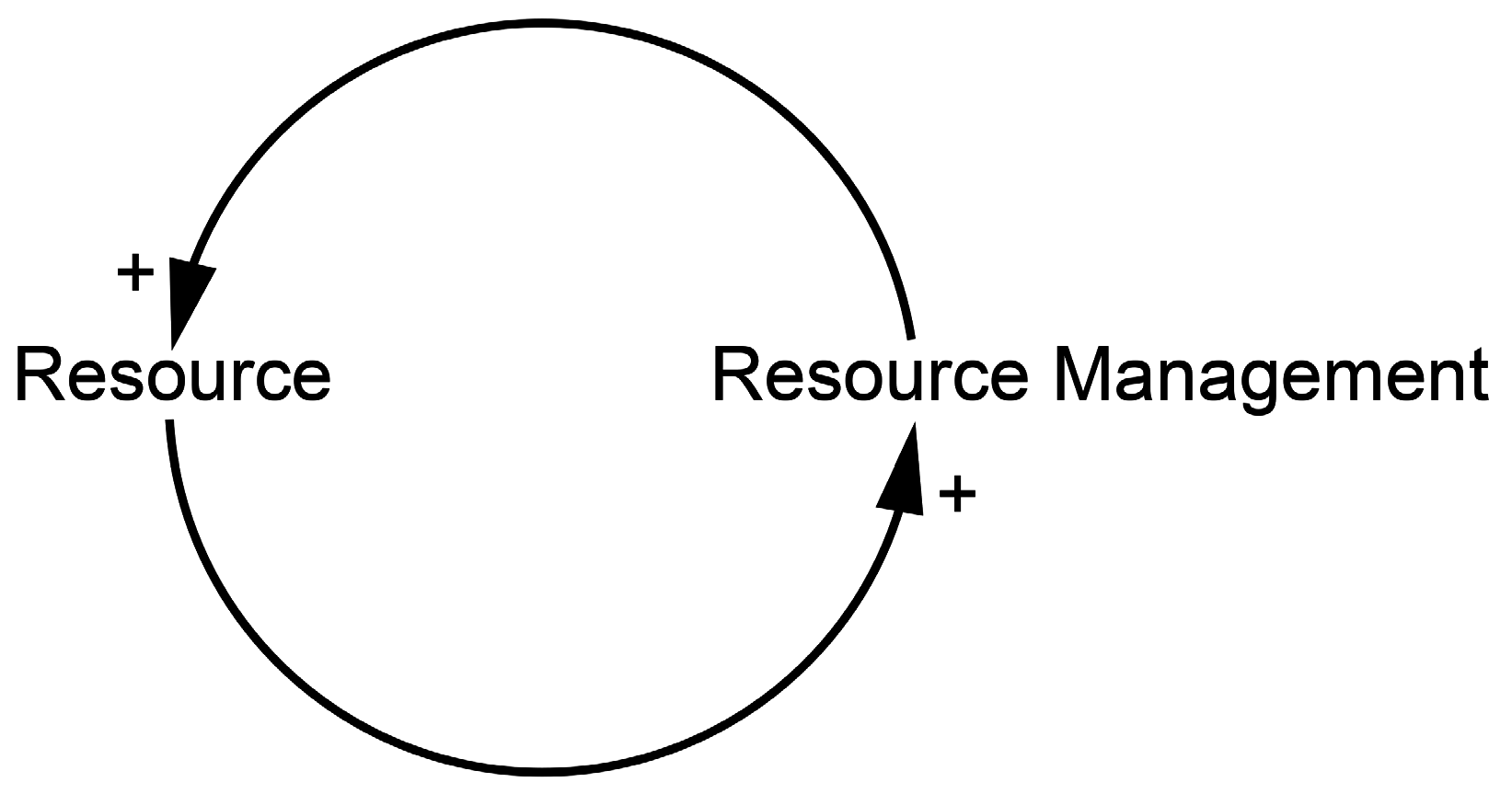
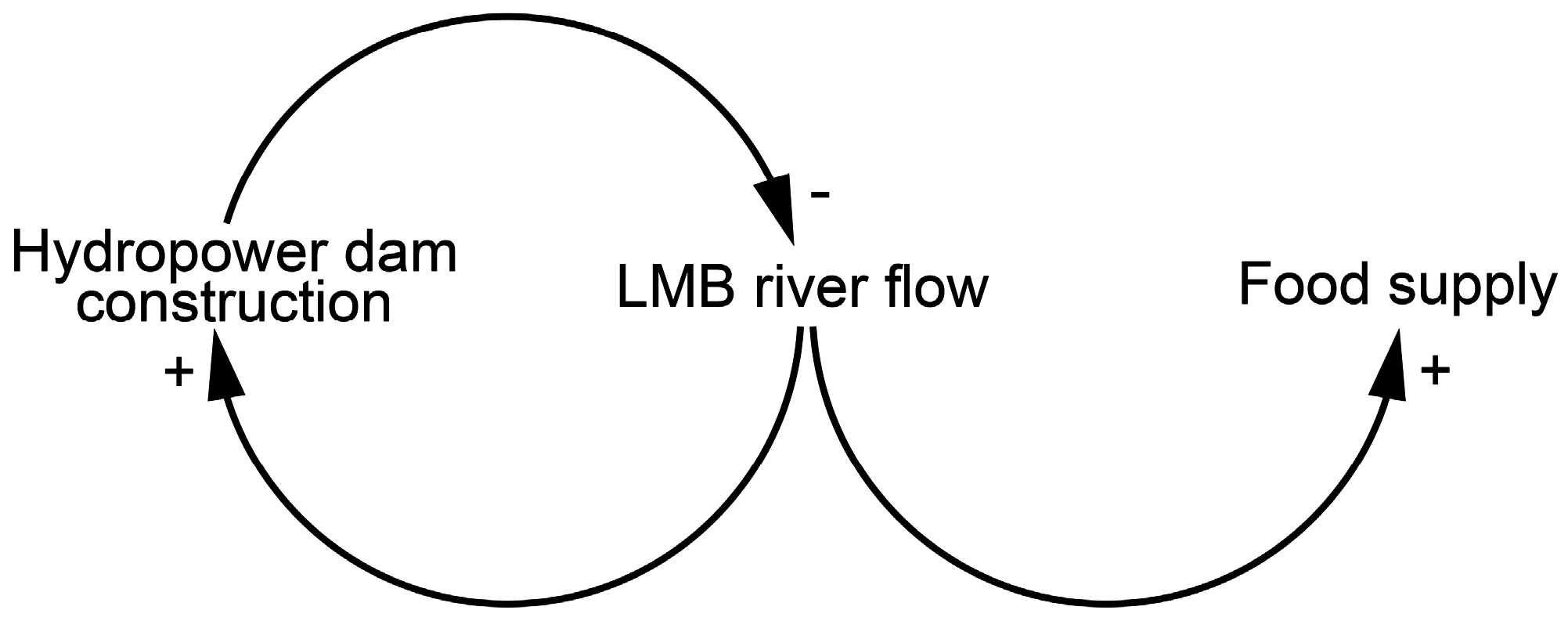
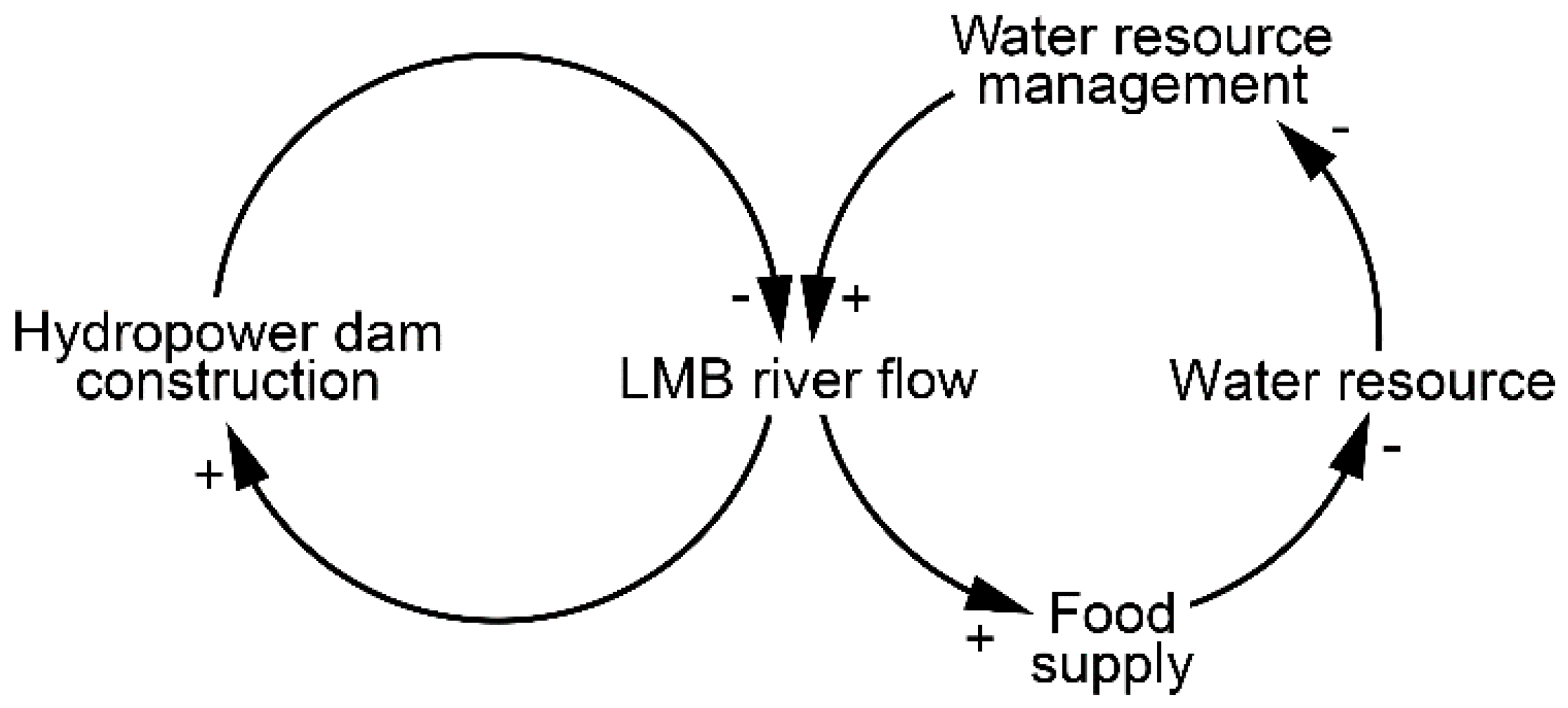
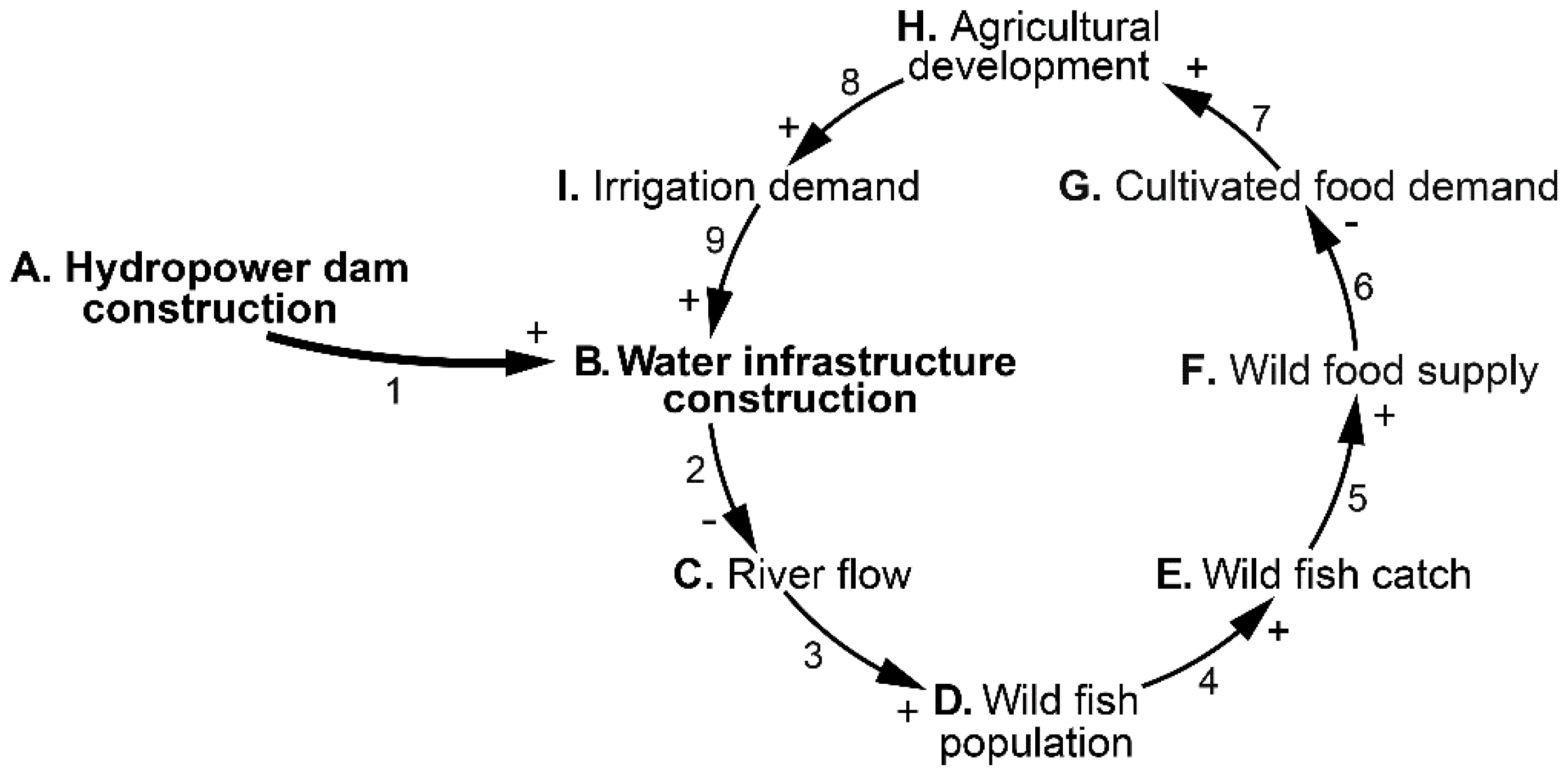

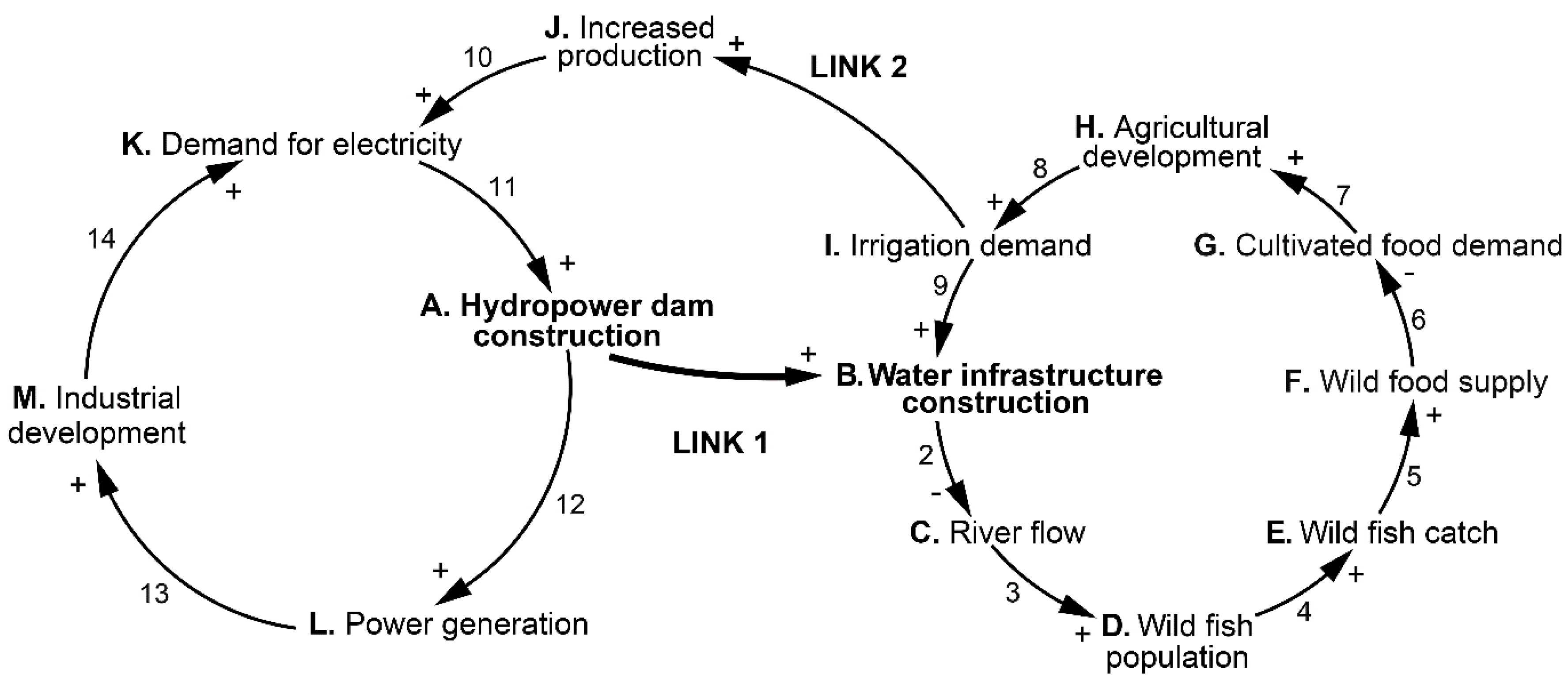
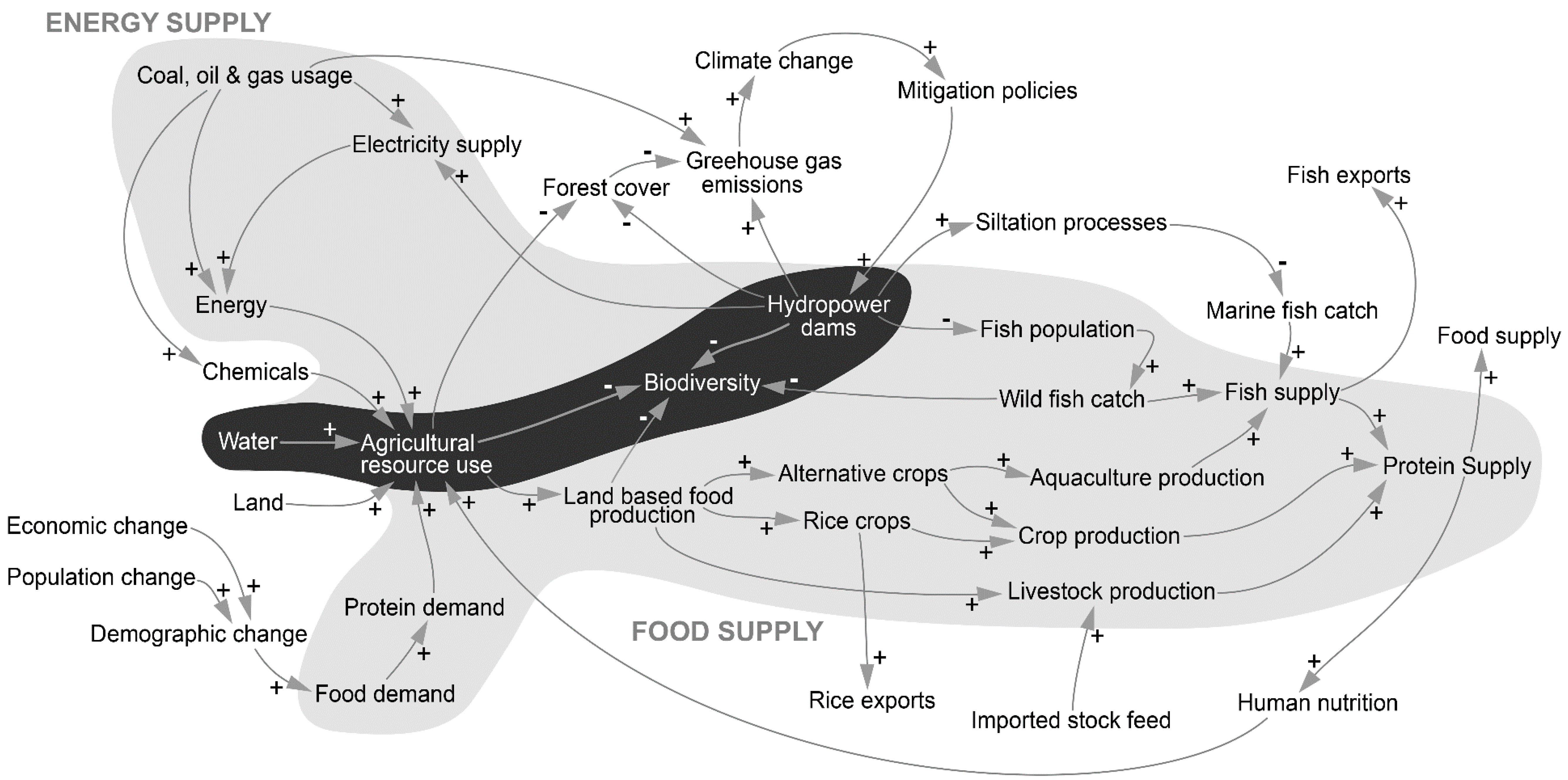
| Variable A | Variable B | Sign |
|---|---|---|
| ↑ | ↑ | + |
| ↓ | ↓ | + |
| ↑ | ↓ | − |
| ↓ | ↑ | − |
| # | Variable | Definition |
| A | Hydropower dam construction | There were 46 hydropower dams in the Mekong River basin in 2015 [7] |
| B | Water infrastructure construction | There were 10,800 irrigation projects in the LMB as at 2009 [25] |
| C | River flow | The Mekong River has an annual water discharge to the sea of 475 km3 on average [7] |
| D | Wild fish population | The Mekong River is one of the most biodiverse river systems in the world with 781 fish species described, including a number of globally endangered species [7] |
| E | Wild fish catch | The freshwater wild fish catch in the four LMB states was estimated in 2010 to be two million tonnes of fish per year [26] |
| F | Wild food supply | River flows support a freshwater capture fishery in the four LMB states estimated in 2010 to be two million tonnes of fish per year [26]. In each country, 47%–80% of animal protein for local residents comes from freshwater fisheries, and 90% of this is from capture fisheries [8]. There are other wild foods obtained from freshwater ecosystems as well |
| G | Cultivated food demand | FAOStat Food Balance Tables (2009) provide a country-by-country analysis of apparent consumption of all foodstuffs with aggregate figures for calorie and protein intake on a daily basis. The total average protein intake for the LMB is 66.7 grams per capita per day (g/c/d). Of this 21.4 g/c/d is from animal protein. Of this animal protein intake the proportions coming from fish are 56% for Cambodia, 38% for Laos, 31% for Thailand and 24% for Vietnam [27] |
| H | Agricultural development | In one projection, to replace the diminished wild fish catch resulting from 88 hydropower dams in the LMB in 2030, there would need to be an additional 5.483 Mha of crops, or 2.857 Mha of pasture for livestock, or 4.177 Mha for a combination of crops and livestock [11] |
| I | Irrigation demand | The current area equipped for irrigated agriculture of four million hectares may increase to as much as 10.2 Mha by 2030 under a high development scenario, with a growing portion of the land used for second and third crops during the year [25]. In 2000, irrigated agriculture’s consumptive water use was around 72.8 km3 or 15% of annual average Mekong River discharge, half of which was in the Mekong delta [28] |
| # | Causal Links | Definitions |
| 1 | Dam construction increases water infrastructure | By directly providing infrastructure and by increasing dry season flows, hydropower dam construction is projected to contribute to an expansion of water infrastructure for agriculture, domestic and industrial use [7,28], including for 4000 planned new irrigation projects by 2030 in the LMB [25] |
| 2 | Water infrastructure influences river flow | It is projected that river flows will change seasonally and be diminished as water diversion for irrigated agriculture in the Mekong Basin grows to 104.5 km3 in 2025, or 22% of discharge, and 25%–30% of discharge by 2050 [28] |
| 3 | Size of the fish population is influenced by river flows | Seasonally specific river flows support fish populations by enabling migration along the rivers for breeding and access to floodplain habitats in the wet season. The 88 planned hydropower projects by 2030 will increase in active water storage capacity 700% to 69.8 km3, changing the timing of river flows [7]. This construction of planned dams is projected to reduce wild fish populations and catch by 23.4% to 37.8% by 2030 [10]. River flows are also disrupted when water infrastructure forms barriers to migration. A diminution of the wet season area flooded reduces wild fish populations [26] |
| 4 | The wild fish population underpins the fish catch | The size of the wild fish population influences the scale of fish catch [26] |
| 5 | Wild fish catch makes a significant contribution to wild food supply | In each LMB country, 47%–80% of animal protein for local residents comes from freshwater fisheries, and 90% of this is from capture fisheries [8] |
| 6 | The scale of the wild supply of food influences demand for cultivated foods from aquaculture, crops and livestock | Food demand in the LMB region is rising due to growing populations as well as poverty reduction and growing wealth [27,29]. At the same time, hydropower dam development is project to diminish the wild freshwater fish catch by 23.4% to 37.8% by 2030 and thus supply of important protein and other nutrients [10,11] |
| 7 | Demand for food drives agricultural development | If demand is not met this will drive further agricultural development. The options for supplementing food supply include importing food or increasing production of crops, livestock and aquaculture [10,11]. Considerable expansion of food production is projected in the region [25] |
| 8 | Irrigation development is an important component of agricultural development | The current area equipped for irrigation of nearly four million hectares in 2009 may increase to as much as 10.2 million hectares by 2030 under a high development scenario, with a growing area used for second and third crops during the year [25] |
| 9 | Increased demand for irrigation drives new water infrastructure construction | Around 4000 new irrigation projects are planned by 2030 in the LMB that will require levees, canals, water storages and pumping stations [25]. It is projected that water diversion for irrigated agriculture in the Mekong Basin will grow to 104.5 km3 in 2025, or 22% of discharge, and 25%–30% of discharge by 2050 [28] |
| Min/Max | Cambodia (%) | Laos (%) | Thailand (%) | Vietnam (%) |
|---|---|---|---|---|
| Minimum | 6.5 | 2.6 | 1.6 | 0.7 |
| Maximum | 23.1 | 8.2 | 3.3 | 2.1 |
| # | Variable | Definition |
| J | Increased production | In one projection, the area of crop production in the lower Mekong River Basin would need to increase by between 6% and 59% per country to replace the diminished wild fish catch resulting from 88 hydropower dams in the LMB in 2030 [11] |
| K | Demand for electricity | In 2015 annual demand for electricity was around 400,000 GWHr in the LMB [7] |
| L | Power generation | There were 5574 MW of hydropower generation operating or under construction in the LMB in 2010, and 90% of electricity generation in the region is from fossil fuels [7] |
| M | Industrial development | “In common with other countries in the wider East Asia region, over the last two decades the four countries of the LMB have experienced rapid economic development. This has largely been driven by industrial growth, and in particular growth in manufacturing production for export” (p. 54) [7] |
| # | Causal links | Definition |
| 10 | Increased agricultural production increases demand for electricity | There are relatively few options for gravity-fed expansion of irrigated agriculture in the region, with plans for new projects involving large scale lift irrigation or smaller scale pumping from local canals and water bodies [38,45]. Pumping water requires significant amounts of energy, in addition to the energy requirements for producing farm chemicals, transport and processing crops [46] |
| 11 | Increased demand for electricity drives further hydropower construction | The Mekong Basin has 53,000 MW of potentially feasible hydropower generation available based on flows in the Mekong River basin [7]. There are 42 new hydropower dams likely to be constructed in the Mekong Basin by 2030 [7] |
| 12 | Increasing hydropower construction increases generation | Generating capacity of 29,760 MW is possible from identified, planned LMB hydropower projects [7] |
| 13 | More power generation drives industrial development | More power generation drives industrial development. In addition to expanding current growth in manufacturing production for export, a number of new, energy intensive industries depend in large part on hydropower development. Most notable is the proposed mining and smelting of an estimated 300 million tons of exploitable bauxite to produce alumina in Laos. Production of 0.5 M tons of alumina per year would require around 150 MW for smelting and 600–800 MW for downstream processing (and a lot of water) [47]. Production of other mineral products is also likely |
| 14 | Industrial development drives further demand for electricity | All LMB countries show high average annual demand growth rates between 2010 and 2025 of between 5.5% in Thailand and 11.6% in Cambodia based on official forecasts [7]. Economic growth in the region is expected to increase 240% between 2005 and 2030 [7] |
© 2016 by the authors; licensee MDPI, Basel, Switzerland. This article is an open access article distributed under the terms and conditions of the Creative Commons Attribution (CC-BY) license (http://creativecommons.org/licenses/by/4.0/).
Share and Cite
Pittock, J.; Dumaresq, D.; Bassi, A.M. Modeling the Hydropower–Food Nexus in Large River Basins: A Mekong Case Study. Water 2016, 8, 425. https://doi.org/10.3390/w8100425
Pittock J, Dumaresq D, Bassi AM. Modeling the Hydropower–Food Nexus in Large River Basins: A Mekong Case Study. Water. 2016; 8(10):425. https://doi.org/10.3390/w8100425
Chicago/Turabian StylePittock, Jamie, David Dumaresq, and Andrea M. Bassi. 2016. "Modeling the Hydropower–Food Nexus in Large River Basins: A Mekong Case Study" Water 8, no. 10: 425. https://doi.org/10.3390/w8100425
APA StylePittock, J., Dumaresq, D., & Bassi, A. M. (2016). Modeling the Hydropower–Food Nexus in Large River Basins: A Mekong Case Study. Water, 8(10), 425. https://doi.org/10.3390/w8100425






